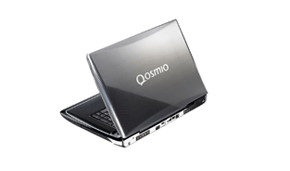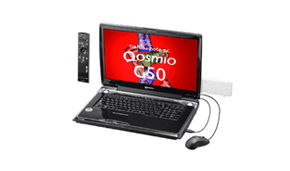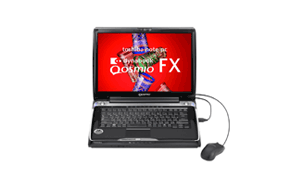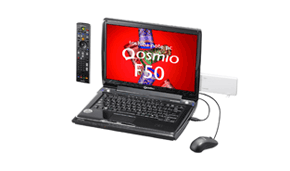Toshiba Launches AV notebook PCs that integrate TOSHIBA Quad Core HD Processor "SpursEngineTM *1" 23 June, 2008
High-resolution function upscales standard images to high definition quality
TOKYO--Toshiba Corporation today announced that it will enhance its Japanese line-up of industry leading Qosmio AV notebooks with the launch of new models, the Qosmio G50 series and Qosmio F40 series, that integrate the streaming media processing power of the TOSHIBA Quad Core HD Processor SpursEngine™ SE1000 ("SpursEngine™"). Both new series will be brought to market in Japan in late July. In parallel, Toshiba also announced the launch of the new dynabook Qosmio FX, which integrates the latest high performance graphics processor. As computers continue to add functionality, they are increasingly used to create, edit, download and view video sources at ever-higher definitions. However, image recognition and processing imposes increased burdens on the CPU performance. The SpursEngine™ removes these burdens, and brings powerful new functions to the Qosmio line-up. Derived from the high performance multi-core technology of the Cell Broadband Engine™*2 (Cell/B.E.), and combined with Toshiba's advanced image processing technology, the SpursEngine™ integrates four synergistic processing elements (S.P.E.s)*3 and functions as a dedicated co-processor*4 that supports the smooth handling of high definition video streams, image recognition and image processing. This new processor is designed to remove the burden of processing high definition video data streams from CPU, and it significantly improves processing power and speeds up the handling of multiple, resource-intensive video processing tasks such as conversion of standard definition video content to high definition quality. The capabilities of the SpursEngine™ go far beyond simply supporting the CPU, and bring a whole range of new features to the new Qosmio G50 series and Qosmio F40 series. First among these is support for Toshiba’s breakthrough "High-resolution function" that upscales standard definition video sources and bring them to screen in high definition picture quality. This allows users to experience standard DVD video content with high definition quality. Users viewing video on the new Qosmios can also enjoy other new functions. The "Face navigation function" recognizes and memorizes faces as they appear on screen, and displays them in an easily searched index that can be used to playback video segments featuring a specific person. "Scene Thumb" takes thumbnail snapshots of a user-recorded video, lines them up one after another, and any one can be individually viewed by running the cursor over it. "Scene Thumb" provides users with a unique approach to finding just the moment they want to view. Another feature of thumbnail search is the ability to search by highlight level and section bar, allowing viewers to home on in, for example, heavy applause during a concert video. The high-end Qosmio G50 series also adds "Gesture Control" for gesture-based interfacing: simple hand movements captured by the PC’s integrated CCD camera, can be used to control video playback and pause, for example, without a mouse or remote controller. One aspect of the new Qosmio performance that users will really appreciate is its extensive range of recording capabilities. In addition to the ability to upscale standard definition video to high definition quality as it records, the new Qosmios are also able to cut recording time by half, and to boost recording density by a factor of approximately eight—recording up to eight hours of video on the storage capacity usually required for one hour*5. This is done by real-time compression of high definition digital terrestrial broadcasts into the H.264 format during recording. Along with the SpursEngine™, the new Qosmios also integrate a complete suite of the latest hardware, including a next generation Intel® CPU processor and the latest NVIDIA graphic accelerator. The result is a platform offering high-speed processing and high-level graphic processing. Toshiba has also given the new Qosmio PC a more sophisticated and elegant design, by forming a distinctive pattern on the surface of the case during molding. The high-end Qosmio G50 series complement stylish appearance with an 18.4-inch LCD with 16:9 aspect ratio, which adds a new level of dynamism to enjoyment of video sources. In advancing its strategy of adding differentiating technologies to commodity products, Toshiba also unveiled the dynabook Qosmio FX series, which achieve enhanced graphic processing by integrating the latest NVIDIA graphic accelerator. High speed graphic capabilities make it a great notebook PC for gamers. Toshiba remains committed to providing users around the world with innovative notebook PCs that bring those new capabilities and heightened convenience. Toshiba also seeks to contribute to lower CO2 emissions from the home by developing notebook PCs that use less energy than desktop PCs. Outline of New Models Qosmio series
| Model Name |
Launch in Japan |
Suggested Retail Price |
Qosmio G50
|
G50/98G |
Late July |
Open |
| G50/97G |
Late July |
| Qosmio F50 |
F50/88G |
Late July |
dynabook Qosmio FX series
| Model Name |
Launch in Japan |
Suggested Retail Price |
dynabook
Qosmio FX |
FX/77G |
Late July |
Open |
Key Features of New Products Qosmio series 1. Integration of TOSHIBA Quad Core HD Processor "SpursEngineTM". The new Qosmio G50 series and Qosmio F40 series feature the TOSHIBA Quad Core HD Processor SpursEngine™, derived from the high performance multi-core technology of the Cell Broadband Engine™*2 (Cell/B.E.) and combined with Toshiba's advanced image processing technology, that supports the smooth handling of high definition video streams, real time image recognition and image processing. This high performance co-processor makes it possible to remove the burden of processing high definition video data streams from the CPU, and allows smooth handling of HD video content. (1) High-resolution function:
This function is able to upscale standard-definition video to high-definition video quality, allowing users to enjoy standard DVD video content at high definition quality (2) Up to eight times recording of digital terrestrial recording:
Users can select from five recording modes: TS mode (MPEG-2, HD quality, rate 17.0Mbps), XP mode (H.264, HD quality, rate 10.0Mbps), SP mode (H.264, HD quality, rate 8.0Mbps), LP mode (H.264, HD quality, rate 5.5Mbps) and LLP mode (H.264, SD quality, rate 2.0Mbps). Real-time compression of high definition digital terrestrial broadcasts into the H.264 format during recording minimize use of storage to approximately one-eighth of that usually required*5. Therefore, users can record digital terrestrial broadcasts without concern for remaining HDD capacity. (3) Cutting recording time to DVD discs by half *5 :
By shortening the reading time by half when encoding, the new Qosmios allow users to record digital terrestrial broadcast or video content to DVD discs in half the time taken by previous models. (4) "Face Navigation" function:
a. "Face Thumb" indication
The function recognizes and memorizes faces as they appear on screen, and displays them in an easily searched index that can be used to playback video segments featuring a specific person. 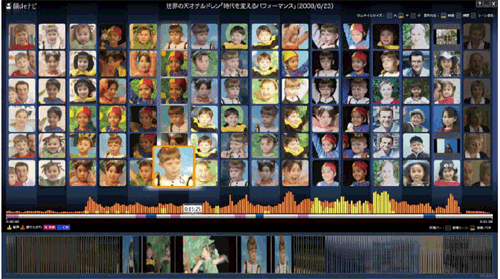
b. "Scene Thumb" indication
“Scene Thumb” takes thumbnail snapshots of a user-recorded video, lines them up one after another, and any one can be individually viewed by running the cursor over it. “Scene Thumb” provides users with a unique approach to finding just the moment they want to view. 
c. "Volume Level" indication
This function allows viewers to home on in, for example, heavy applause during sports live coverage or a highlight scene. A section bar allows viewers to indicate specific scenes by different colors, making it even easier to locate favorite moments. 
(5) Ulead DVD MovieWriter™ for TOSHIBA
When users record HD video content from a video camera , this function creates a low definition file for editing, allowing users to edit HD content quickly and smoothly. Furthermore, transcoding of such edited HD content can be completed approximately 10 times faster when the SpursEngine™ is activated. (6) Gesture Control (Qosmio G50 series):
Support for gesture-based interfacing: simple hand movements captured by the PC's integrated CCD camera, can be used to control video playback and pause, for example, without a mouse or remote controller. 2. Advanced audio-visual functions (1) Integration of REGZA LINK™
By connecting the PC to a Toshiba REGZA™ TV via an HDMI cable, users can enjoy HD video content stored in the PC on a large-screen TV. Users can also control the PC with a single REGZA remote control unit. (2) Integration of dual digital terrestrial tuners
Users can record two different digital terrestrial programs, even when they are broadcast at the same time, and record one program while watching another. (3) Support for "Dubbing 10", a new Japanese recording rule
The function allows users to copy digital broadcasts recorded in a HDD up to nine times and move it to different equipment one time. (4) Small antenna for digital terrestrial broadcast
The new Qosmio 50 series and Qsomio F50 series include an antenna for digital terrestrial broadcast. 3. Integration of the latest processor With the integration of advanced technology, the new PCs achieve high-speed processing and high graphic indication. (1) Next generation Intel® Core™ 2 Duo processor
Intel's latest 45nm process technology realizes strong high speed system performance with lower power consumption. The new processor lessens burdens when editing large amounts of data or working with multiple applications simultaneously.
* The details and official name of Intel's CPU will be announced on Toshiba's notebook PC web site, http://www.dynabook.com, as soon as it is confirmed by Intel. (2) Latest NVIDIA graphic accelerator
Designed to get the most from widescreen visual performances, the new PCs integrate the new NVIDA® GeForce®9600 GT, which interfaces with Microsoft® DirectX® 10. Users can enjoy a smooth and impressive video experience, even in high resolution, high definition 3D games or movies. (3) Latest interfaces
Allows users to transfer large volumes of data from the HDD at a speed approximately 2.5 times faster than USB 2.0. 4. Newly designed external case
With adopting the IMR method, the external features enhance high quality and premium feel thanks to the gradation and finish design in details. 5. Large LCD screen (Qosmio G50 series)
The high-end Qosmio G50 series complements stylish appearance with an 18.4-inch LCD with 16:9 aspect ratio, the same ratio as that of high-definition TVs, which adds the enjoyment of full screen viewing of content.
*With some programs and DVD video sources, black bands might appear at the top and bottom of the screen. dynabook Qosmio FX series (1) Next generation Intel® Core™ 2 Duo processor
Intel's latest 45nm process technology realizes strong high speed system performance with lower power consumption. The new processor lessens burdens when editing large amount of data or working with multiple applications simultaneously.
* The details and official name of Intel's CPU will be announced on Toshiba's notebook PC web site, http://www.dynabook.com, as soon as it is confirmed by Intel. (2) Latest NVIDIA graphic accelerator
Designed to get the most from widescreen visual performances, the new PCs integrates the new NVIDA® GeForce®9600 GT, which interfaces with Microsoft® DirectX® 10. Users can enjoy a smooth and impressive experience, even in high resolution, high definition 3D games or movies. Qosmio series, dynabook series Environmentally conscious notebook PC (1) RoHS*6 and J-Moss (Green Mark)*7compatible
Toshiba's notebook PCs contribute to achievement of environmentally conscious products . (2) Toshiba's notebook PCs contribute to lower CO2 emissions.
Use of Toshiba dynabook and Qosmio PCs will contribute to lower CO2 emission from the home by approximately 80g per day*8, or almost 30kg per year*9. This is half the level of CO2 emissions from desktop PCs. While Toshiba remains committed to providing users around the world with innovative notebook PCs that bring new capabilities and heightened convenience, Toshiba also seeks to contribute to lower CO2 from the home by developing notebook PCs that use less energy than desktop PCs. Toshiba Group, a Corporate Citizen of the Planet Earth, is committed to realizing a better environment. Guided by "Toshiba Group Environmental Vision 2050" the Group is implementing measures to boost environmental efficiency by 10 times in FY2050, against the benchmark of FY2000. The core target is to reduce projected CO2 emissions by a total equivalent to 117.7 million tons a year by FY2025, through the development and sales of highly efficient power supply equipment and systems, and the manufacture of environmentally conscious home appliances and office equipment. By working to mitigate global warming, make efficient use of resources and control management of chemicals, Toshiba Group creates value for people and promotes lifestyles in harmony with the Earth.
| *1: |
SpursEngine and the SpursEngine logo are trademarks of Toshiba Corporation.
SpursEngine is only used in the Japanese market; in other regions it is Toshiba’s Quad Core HD Processor. |
| *2: |
Cell Broadband Engine is a trademark of Sony Computer Entertainment Inc. |
| *3: |
Synergistic Processor Element is a processor core that has high performance floating point computation capability with an original instruction set architecture, for optimized processing of multiple media applications. |
| *4: |
Cell/B.E., jointly developed by IBM, Sony Group and Toshiba, is a breakthrough design featuring a central processing core based on IBM’s Power Architecture technology and eight synergistic processing elements (SPE). Cell/B.E. brings an unseen level of broadband processing power to digital products. |
| *5: |
Comparison between a Toshiba notebook with and without TOSHIBA Quad Core HD Processor. Performance may vary depending on product model, configuration, video content, format and settings, as well as the performance variations of individual hardware components. Results were achieved on select models and configurations tested by Toshiba at the time of publication. |
| *6: |
RoHS is a European Union environmental directive that eliminates the use of six hazardous substances in electrical and electronic equipment. |
| *7: |
J-Moss is the framework for disclosure of information on chemical substances defined in the Japanese Industrial Standards contained in electrical and electronic products. |
| *8: |
Calculated as one PCs per person |
| *9: |
CO2 emissions are calculated based on the method developed by the Research Center for Life Cycle Assessment (LCA). Based on the usage conditions (in households) defined by The Energy Conservation Center, the requirements for calculating LCA are: use for 15 hours per week (operating mode: 10 hours, stand-by mode: 5 hours), based on 52 weeks (one year) and five years of PC usage. The calculation is based on mainstream notebook PC (15-inch LCD with Celeron type CPU) and desktop PCs with similar specifications that are in wide use. |
Outline of Key Specifications
As of June 23, 2008
| |
Qosmio G50/98G |
Qosmio G50/97G |
Qosmio
F50/88G |
dynabook
Qosmio
FX77G |
| OS |
Windows Vista™ Home Premium Edition with Service Pack 1 |
| CPU |
Next Generation Intel® Core™2 Duo Processor |
| Memory/Max |
2GB (1GB x 2)/4GB |
| Display |
18.4-inch Full HD
Clear Super View LCD
(1,920×1080 pixels)
2 lamps, high luminance |
15.4-inch WXGA
Clear Super View LCD (1,280×800 pixels)
2 lamps, high luminance |
15.4-inch WXGA
Clear Super View LCD (1,280×800 pixels) |
| HDD |
500GB (250GBx2)
(5,400rpm Serial ATA) |
250GB
(5,400rpm Serial ATA) |
200GB
(5,400rpm Serial ATA) |
| Drive |
DVD SuperMulti |
| Graphics |
NVIDIA® GeForce® 9600M GT(PCI Express) |
| Image Processor |
TOSHIBA Quad Core HD Processor SpursEngine™ |
-- |
| Sound |
3 speakers (harman/kardon® stereo and sub-wooder) |
| LAN |
1000Base-T,/100Base-T
IEEE802.11a/b/g/n draft 2.0 (wireless) |
| TV tuner |
Dual Tuners for Digital Terrestrial Broadcast |
-- |
| Interface |
Optical audio output, RGB, USB2.0x 4 (one usable for eSATA ) , Mike, iLink, LAN, HDMI, Antenna input |
Optical audio output, RGB, USB2.0x 4 (one of them usable for eSATA as well) , Mike, iLink, LAN, HDMI |
| Battery Life |
Approx. 4.0 hrs |
Approx. 1.8 hrs |
Approx. 2.4 hrs |
| Dimensions |
Approx. 452.3 x 311.0 x 38.2~48.3 mm |
Approx. 368.0x 278.0 x 38.0~47.0 mm |
| Weight |
Approx. 4.9kg |
Approx. 4.8kg |
Approx. 3.6kg |
Approx. 3.3kg |
| Eco |
RoHS Directive,J-Moss (Green Mark) |
| Application |
Microsoft® Office Personal 2007 SP1with
Microsoft® Office PowerPoint® 2007 |
Microsoft® Office Personal 2007 SP1with
Microsoft® Office PowerPoint® 2007 |
The details and official name of Intel's CPU will be announced on Toshiba's notebook PC web site, http://www.dynabook.com, as soon as it is confirmed by Intel. * 1GB is calculated on the basis of 1GB = 1-billion bytes.
- Names of products mentioned in this press release may be registered trademarks or trademarks of specific companies.
- Intel, Intel Centrino, Pentium, and Celeron are registered trademarks or trademarks of Intel Corporation.
- Microsoft and Windows are registered trademarks or trademarks of Microsoft Corporation in the U.S. and in other countries.
- The formal title of Windows is Microsoft Windows Operating System..
- i.Link and i.Link logos are registered trademarks.
- Specifications are subject to change without prior notice.
|



